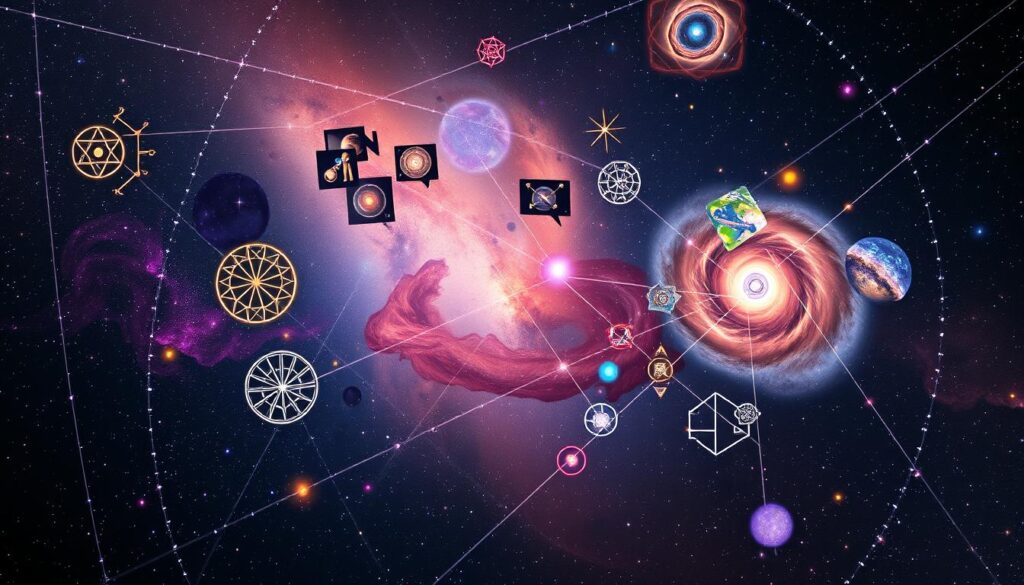“The cosmos is within us. We are made of star-stuff. We are a way for the universe to know itself.” – Carl Sagan
The night sky has always fascinated us. For thousands of years, people looked to the stars for guidance. From ancient sailors to today’s scientists, the stars’ language has intrigued us.
Now, we’re on the brink of a new understanding. We’re learning more about the universe and our role in it. This knowledge is changing how we see the cosmos and our place in it.
Key Takeaways
- Celestial bodies communicate through various means, including electromagnetic signals, gravitational waves, and light spectra.
- Modern astronomy and technology have significantly advanced our understanding of the cosmos, allowing us to decipher the language of the stars.
- The study of celestial linguistics has implications for fields ranging from navigation and astrology to interstellar communication and the search for extraterrestrial intelligence.
- Decoding the language of celestial bodies can provide insights into the fundamental laws of the universe and the origins of life itself.
- Understanding the language of the cosmos can help us establish a deeper connection with the natural world and our place within it.
The Ancient Art of Reading Celestial Messages
For thousands of years, humans have been drawn to the stars. They believed the night sky held secrets and messages. Astrolinguistics, the study of these messages, was key in early navigation and astrology.
Early Civilizations and Star Interpretation
The Egyptians, Greeks, and Mayans saw deep meaning in the stars. They thought the stars and planets could reveal the universe’s secrets. These cultures watched the skies closely, mapping constellations and tracking planets to understand celestial navigation and divine messages.
Historical Navigation Methods
Old sailors used the stars to navigate, like the Polynesians and Norse Vikings. The stars were their map, guiding them across oceans. By reading the stars, they could find their way, making star whispering crucial for their journeys.
Cultural Significance Across Time
Constellations have inspired countless myths and legends. From Greek tales of Orion to Māori stories of Matariki, they’ve captured our imagination for ages. Today, astrolinguistics still fascinates, with astrology remaining popular, despite some doubts about its science.
“The cosmos is within us. We are made of star-stuff. We are a way for the universe to know itself.”
– Carl Sagan

Understanding Cosmic Communication Patterns
The universe is full of mysteries, and studying the language of stars is one of them. Scientists are exploring extraterrestrial language analysis and interstellar semantics. They aim to uncover the secrets of the universe through cosmic communication patterns.
Studying electromagnetic signals from space is a big part of this work. The Search for Extraterrestrial Intelligence (SETI) uses radio telescopes to find signals. They look for messages from other intelligent life forms. By understanding these signals, scientists hope to grasp the language of the cosmos.
Scientists also look at the patterns of stars and their movements. These patterns have long fascinated humans. They might hold the key to understanding the language of the stars. Each movement and vibration could be part of a cosmic conversation.
“The cosmos is within us. We are made of star-stuff. We are a way for the universe to know itself.” – Carl Sagan
The study of interstellar semantics is becoming more important as we learn more about the universe. By studying cosmic language, scientists aim to connect Earth with space. This could lead to new ways of communicating and working together across the universe.

Decoding the Language of Celestial Bodies
The cosmos is full of celestial bodies sending out their own signals. As astronomical hermeneutics fans, we can learn to understand these messages. We can figure out the rules that guide planets, stars, and galaxies.
Electromagnetic Signals from Space
Radio astronomers study the waves from far-off objects. They look for clues about stars and even if aliens might be trying to talk to us. By decoding these signals, we might learn secrets of the universe.
Interpreting Stellar Frequencies
Every star has its own unique sound, hidden in its frequencies. These sounds tell us about a star’s inside, what it’s made of, and how old it is. By listening to the stars, we can understand the universe’s dance.
Patterns in Celestial Movement
- Planetary alignments and orbital resonances provide insights into the dynamics of solar systems and galaxies.
- The cyclical nature of celestial movements, such as the precession of the equinoxes, can reveal the underlying order of the cosmos.
- Studying the astronomical hermeneutics of these patterns can help us uncover the hidden language of the cosmos.
Exploring the cosmic interpretation of celestial bodies reveals a vast, complex web of communication. It invites us to learn the language of the stars.
| Celestial Body | Electromagnetic Signals | Stellar Frequencies | Movement Patterns |
|---|---|---|---|
| Stars | Provide insights into composition, age, and activities | Reveal internal structure and stage of life | Orbital patterns offer clues about solar system dynamics |
| Planets | Can help detect potential extraterrestrial communications | Contribute to understanding planetary systems | Alignments and resonances shed light on solar system structure |
| Galaxies | Electromagnetic signals from distant galaxies offer insights into their formation and evolution | Stellar frequencies in galaxies provide information about their internal composition and dynamics | Galactic movement patterns reveal the underlying structure and evolution of the universe |
The Role of Modern Technology in Celestial Linguistics
In the world of astrolinguistics and cosmic communication technology, new tech has changed how we study and understand messages from space. We now have tools like advanced telescopes and space-based observatories. These help us detect and analyze signals from far-off places with great accuracy.
Computers and artificial intelligence are also key. They help us sort through huge amounts of data. This way, we can find patterns or oddities that might mean someone is trying to talk to us. These advances have opened up new ways for us to learn about the stars and our universe.
| Technology | Contribution to Celestial Linguistics |
|---|---|
| Advanced Telescopes | Enhances our ability to observe and study distant celestial bodies, providing detailed data for linguistic analysis. |
| Radio Arrays | Allows for the detection and interpretation of radio signals from extraterrestrial sources, potentially containing communication-like patterns. |
| Space-based Observatories | Offers a unique vantage point for studying the universe, free from the distorting effects of Earth’s atmosphere, enabling more accurate celestial observation and signal detection. |
| Computational Tools and AI | Facilitates the processing and analysis of vast amounts of astronomical data, helping scientists identify potential communication signatures in the cosmos. |
As we explore more, these new tools are crucial for understanding the universe. They help us unlock secrets of astrolinguistics and cosmic communication technology. With these advancements, we’re making big strides in discovering new things and understanding our role in the universe.
Astronomical Hermeneutics: Breaking Down Cosmic Messages
Exploring the cosmos has made interpreting celestial signals crucial. This field, called astronomical hermeneutics, uses many techniques. It helps us understand the universe, from radio waves to light spectrums and gravitational waves.
Radio Wave Analysis
Radio waves from space are a key part of this field. They might show signs of alien life. Scientists study these waves to see if they come from intelligent beings.
Light Spectrum Interpretation
Light spectrums from stars and planets are also important. They tell us about the universe’s makeup. By studying these spectrums, we learn about the universe’s history and life possibilities.
Gravitational Wave Detection
Gravitational waves are a new area of study. They help us understand cosmic events like black hole mergers. By analyzing these waves, scientists uncover the universe’s secrets.
Together, radio waves, light spectrums, and gravitational waves help us understand the universe. They are key to unlocking its secrets and maybe even finding messages from other worlds.
Interstellar Semantics and Space Communication
In the vast cosmos, galactic linguistics and cosmic language patterns are key. Scientists seek universal principles for interstellar talk. The challenge is to find methods that all civilizations can understand, despite their differences.
One interesting idea is using math and physical constants as a lingua cosmica. The essay “Counting on Beauty” explores this. It talks about the Principle of Mediocrity, saying Earth and humans are not special in the universe.
The METI project sends signals to aliens, showing off our science. It’s a way to say hello and start a conversation with the cosmos.
| Principle | Description |
|---|---|
| Principle of Mediocrity | The hypothesis that Earth and humans are not considered privileged in the universe. |
| Cognitive Maps | A way to represent various aspects of human perception and behavior in constructing an interstellar language to facilitate interspecies cooperation. |
| Incommensurability | The potential challenges in communication between different cognitive maps or paradigms, including methodological and semantic incommensurability. |
| Mathematics as a Cognitive Universal | The idea that mathematics transcends cultural and linguistic boundaries, providing a basis for potential communication with intelligent extraterrestrial beings. |
Exploring galactic linguistics and cosmic language patterns is exciting. It challenges our scientists to find ways to talk to aliens. The search for cosmic secrets and alien friends is a thrilling journey for humanity.
“The pursuit of galactic linguistics and cosmic language patterns holds immense promise as we strive to unlock the secrets of the cosmos and establish a meaningful dialogue with potential extraterrestrial civilizations.”
Xenolinguistics: Bridging the Gap Between Earth and Space
As we learn more about space, xenolinguistics becomes a key area of study. It looks into the languages and ways aliens might communicate. This field mixes linguistics, astronomy, and astrobiology to understand alien speech and how to talk to them.
SETI Communication Protocols
The Search for Extraterrestrial Intelligence (SETI) leads the way in trying to contact aliens. Xenolinguists team up with SETI to make strong ways to talk to space. They aim to find a universal language, using math and science as a base.
Mathematical Universal Languages
Xenolinguistics also explores math-based languages. These use the universe’s laws and constants. They aim to create a way to communicate that everyone can understand, no matter their culture or language.
Binary Message Systems
Another idea is using binary code, like in old computers. This simple method could help us talk to aliens. By using binary, xenolinguists hope to find a way for humans and aliens to communicate.
The study of xenolinguistics is exciting and full of promise. It could help us understand how to talk to aliens and connect with the universe. Through new ideas and teamwork, xenolinguists are making progress in unlocking the secrets of space.
The Future of Galactic Communication
Our understanding of the universe is growing, opening up new possibilities in interstellar messaging and cosmic linguistics. Researchers worldwide are working on new technologies to change how we talk across space.
Quantum communication is a promising area. It uses quantum mechanics to send information faster than light. This could make talking to distant aliens much easier and quicker.
Artificial intelligence and machine learning are also key. They help us understand the complex signals from space. This way, we can figure out what messages are being sent from other worlds.
In 2015, NASA’s Ellen Stofan said we might find alien life in 10 years. This shows how urgent it is to find ways to talk to them. With over 7,100 languages on Earth, it’s a big challenge. But, scientists are making good progress.
Groups like the Cambridge Institute of Exo-Language and Meti are leading the way. They work on sending basic scientific info to aliens. As our tech gets better, talking to other life forms in the universe becomes more possible.
| Advancement | Description |
|---|---|
| Quantum Communication | Harnessing quantum mechanics for faster-than-light information exchange |
| AI and Machine Learning | Crucial for analyzing and interpreting complex cosmic signals |
| Interstellar Communication Protocols | Bridging the gap between terrestrial and extraterrestrial semantics |
| NASA’s Communication Network | Extensive global network of antennas and satellites for space communications |
| Optical Communications | Infrared lasers offering higher data rates than radio wave communications |
The future of interstellar messaging and future cosmic linguistics is exciting. It promises to reveal the universe’s secrets and connect us with life beyond Earth.
“The discovery of alien life would be a turning point in human history, transforming our view of our place in the cosmos.”
– Ellen Stofan, NASA Chief Scientist
Scientific Breakthroughs in Celestial Message Detection
Our quest to understand the cosmos has made great strides. Recent scientific discoveries have improved how we detect and understand messages from space. We now have better tools, from finding exoplanets to detecting gravitational waves.
Discovering exoplanets has opened new paths in searching for life beyond Earth. By studying these planets’ atmospheres and orbits, scientists learn about different worlds. This helps us better search for signals from space.
Gravitational wave detection is another major leap. It lets us see the universe in a new way. We can now detect the huge events that create these waves. This could lead to finding new ways to communicate with the cosmos.
Radio telescopes and interferometers have also improved. They can now pick up faint signals from far away. This makes us closer to understanding messages from space.
Our understanding of the universe is growing. The idea of using the sun’s gravity for communication is exciting. Each breakthrough brings us closer to understanding the cosmic signals that have fascinated us for so long.
“The dream of interstellar communication using the sun’s gravity is reshaping our understanding of the universe and pushing the boundaries of scientific feasibility.”
Conclusion
Exploring cosmic linguistics shows us that understanding the language of space is a never-ending journey. With new tech and a deeper grasp of the universe, we’re getting closer to talking to the stars. This journey excites us and pushes us to think big.
The future of talking to space is full of new discoveries and maybe even meeting aliens. This dream drives science and makes us think deeply about our place in the universe. Seeing the universe’s complexity helps us appreciate how everything is connected.
Looking ahead, the future of cosmic linguistics future and celestial communication advancements is bright. It’s filled with the chance to answer humanity’s biggest questions. Start this amazing journey, and you might just unlock secrets that change how we see the world and our place in it.
FAQ
What are the various means by which celestial bodies communicate?
Celestial bodies talk to each other through electromagnetic signals, gravitational waves, and light spectra.
How have ancient civilizations interpreted the meanings of celestial positions and movements?
Ancient cultures like the Egyptians, Greeks, and Mayans saw deep meanings in the sky. They used it for guidance, navigation, and cultural traditions.
How do scientists study cosmic communication patterns to decipher potential messages from extraterrestrial civilizations?
Scientists look at electromagnetic signals, stellar frequencies, and movement patterns. They search for signals from distant cosmic sources that might show intelligent communication.
What are the different methods used in astronomical hermeneutics to interpret cosmic messages?
Astronomical hermeneutics uses radio wave analysis, light spectrum interpretation, and gravitational wave detection. These methods help us understand the universe’s language.
What are the efforts to develop universal principles and communication methods for interstellar semantics?
Projects like the Messaging Extraterrestrial Intelligence (METI) send signals to show humanity’s science. They explore using mathematical and physical constants as a universal language.
How does xenolinguistics focus on potential alien languages and communication methods?
Xenolinguistics works on SETI communication protocols, universal math languages, and binary systems. These are ways to talk to extraterrestrial life.
What are the recent scientific breakthroughs that have enhanced our ability to detect and interpret celestial messages?
New discoveries like exoplanets and better gravitational wave detection have helped. So have advanced radio telescopes and interferometers. These advancements have boosted our ability to find and understand cosmic messages.




























































